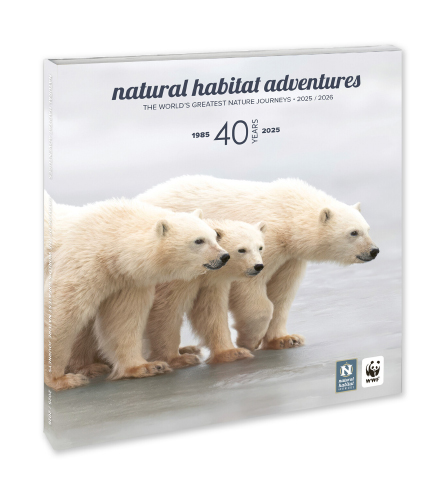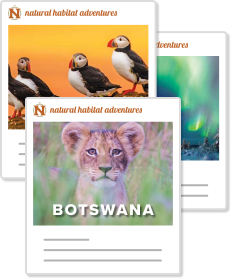Women’s travel, especially solo and adventure-focused travel, has seen a significant surge over the last decade.
And while we might think of travel as a luxury, new research suggests that we should perhaps instead think of it as a way to take care of ourselves—and contribute to others’ well-being while we’re at it.
Women’s Travel on the Rise
Here are some recent stats on women’s travel habits:
- Between 2016 and 2023, Google searches for “solo female travel” increased by 230%.
- Approximately 75% of guests on cultural, adventure or nature trips are women.
- Global adventure travel is projected to grow at a compound annual growth rate of 16.8% from 2025 to 2030.
- The average age of adventure travelers is 49 years old, with 43% of adventure travel tour operator clients between the ages of 51–70.
Taken together, these numbers represent millions of women. That means that women’s travel is more than just a market trend—it’s an opportunity for profound, lasting health benefits.
Health Benefits of Women’s Travel
Here are five big benefits of women’s travel, supported by recent research. The TL;DR? Adventure travel provides rich experiences in nature, reduces stress and improves heart health, and offers social interactions that impact not only travelers but also the communities they visit.
At the end of this post, you’ll find links to stories from women conservationists around the world, as well as from some of our own Nat Hab Expedition Leaders!

Northern Lights & Arctic Exploration © Nat Hab Staff Megan Brief
1. Travel Facilitates Social Connection
Adventure travel offers women unique opportunities to forge meaningful social connections, which can have profound and lasting benefits for both mental and physical health. Social bonds created through travel, especially in group adventure settings, provide support, enhance resilience and can even increase longevity:
- Improves Longevity and Health: A large and growing body of research shows that the degree to which we are socially connected across our lifespan significantly improves our physical and psychological health, even longevity. A meta-analysis reveals that individuals with robust social networks have a 50% greater likelihood of survival over time compared to those with weaker social ties.
- Nurtures a Sense of Belonging and Purpose: Adventure travel often involves collective activity, from navigating unfamiliar terrain to contributing to local conservation efforts. This shared purpose fosters a sense of belonging. Adventure travel offers a space to feel connected and create memories and friendships that endure well beyond the trip.
Women’s adventure travel fosters strong social connections that enhance physical health, mental resilience and overall well-being. For women, these connections offer a powerful reminder of the strength found in community and the value of exploring the world together.

Grand Canyon & Sedona Escape © Courtney Kent
2. Being in Nature Has Clear Health Benefits
“I cannot say exactly how nature exerts its calming and organizing effects on our brains, but I have seen in my patients the restorative and healing powers of nature and gardens…” – Dr. Oliver Sacks
Adventure travel offers women the chance to leave behind the daily hustle and immerse ourselves in the natural world—where fresh air, beautiful landscapes, and wildlife encounters can rejuvenate body and mind. Nature-based and conservation travel provides remarkable health benefits that go beyond simple relaxation, encouraging a renewed sense of vitality and inner calm.
- Boosts Physical and Mental Health: Stepping into nature, whether on a forest trail or beside a tranquil lake, has powerful effects on well-being. Spending at least 120 minutes in nature per week has been shown to improve overall health, according to a study by the University of Exeter on Nature.com. This research found that time outdoors can lower blood pressure, reduce inflammation and lift mood. Even small amounts of time in natural settings make a difference, giving our bodies and minds the chance to recharge in ways everyday life can’t match.
- Enhances Immune Function: Spending time in green spaces supports our body’s defenses in ways science is only beginning to fully appreciate. One of the coolest results I’ve read showed that even being in green space for as little as 10 minutes has a demonstrable effect on the brain.
- Wildlife Encounters Promote Mental Well-being: Watching wildlife, whether it’s birds along a forest path or marine life from the shore, can soothe the soul. WWF highlights how encounters with wildlife can reduce symptoms of anxiety and stress, helping travelers find a sense of emotional balance. Observing nature provides a calming effect that lowers stress, fosters gratitude, and enhances mental clarity—benefits that often last long after returning home.
Adventure travel, with its opportunities for connection to nature, offers more than scenic views; it provides the setting for profound renewal of body and spirit. Whether you’re hiking through a lush forest or watching animals in their natural habitat, these experiences offer lasting health benefits.

Hidden Yellowstone & Grand Teton Safari © Nat Hab Staff Megan Brief
3. Taking a Break Can Improve Heart Health
Adventure travel can provide significant cardiovascular benefits, especially for women over 45, for whom heart disease is the leading killer. Research suggests that regular getaways and the physical activity associated with travel can support heart health in multiple ways.
- Frequent Vacations Lower Heart Disease Risk: Women who vacation more often show a lower risk of heart disease. This is especially important because heart disease is by far the most common health challenge facing women over 40. A study from the American Journal of Epidemiology, based on data from the Framingham Heart Study, found that women who took only one vacation every six years were twice as likely to have a heart attack or coronary death than women who had a couple of breaks each year.
- Increase in Physical Activity: I don’t know about you, but my watch tells me I get a lot more steps in when I’m on vacation than when I am at home. Travel often involves more movement, whether it’s exploring new locations, hiking, or simply walking through markets. The CDC recommends 30 minutes of moderate activity most days for heart health, and vacationing often naturally includes this activity, helping to reduce cardiovascular risk.
- Reduces Cortisol and Blood Pressure: Stress reduction is crucial for heart health. Studies from the University of Pittsburgh Medical Center show that even short getaways help reduce cortisol, a stress-related hormone, while also lowering blood pressure. Lowering these biomarkers lessens cardiovascular strain, particularly important for women in midlife.
- Long-Lasting Benefits: Taking short vacations, even just a few days, can create long-term relaxation effects. The Wisconsin Rural Women’s Health Study found that women who vacation at least twice a year are less likely to experience chronic stress and depression compared to those who vacation less than once every two years.
Bonus—Even travel anticipation reduces stress. Even just planning a trip can improve mental and physical health. A Cornell University study found that anticipating travel often leads to increased happiness, even more so than material purchases. Studies have shown that even if you don’t go on the trip, planning still can provide health benefits!

Iceland: Circling the Land of Fire & Ice © Nat Hab Expedition Leader Jackie Weston
4. Travel Connects Us with Ourselves and the World Around Us
Beyond physical health benefits, travel provides women with opportunities for personal growth, empowerment and reflection. Wildlife and conservation travel, in particular, encourages us to step out of our daily routines, inspiring creativity, mindfulness and awe.
- Fuels Creativity and Improves Problem-Solving: Work and organizational psychologists have shown that travel can increase creativity by relieving workers from stress, providing diversifying experiences and increasing positive emotions. Consequently, travel may boost creativity, apparent in greater cognitive flexibility.
- Increases Mindfulness and Emotional Resilience: Travel often brings unfamiliar situations that help cultivate mindfulness and adaptability. The Greater Good Science Center at UC Berkeley notes that exposure to new experiences enhances emotional resilience and supports mental clarity.
By offering space for creativity, mindfulness, and restoration, travel becomes a powerful way for women to reconnect with themselves and rediscover their inner strength. Adventure travel, in particular, provides profound opportunities to enhance mental clarity and emotional resilience, creating benefits that last well beyond the journey itself.

Women’s Weaving Coalition © Andrew Morgan
5. Travel Contributes to Local Communities
From the Arctic to Machu Picchu & Peru’s Sacred Valley, travel can contribute to local communities, increasing public health infrastructure literacy, economic livelihoods and conservation outcomes.
- Encourages Conservation and Biodiversity: WWF emphasizes that sustainable conservation-based travel shows can bring essential funds to protected areas, aiding biodiversity and helping to preserve wildlife habitats and local people and culture. Destinations from Costa Rica to Alaska have seen positive impacts on ecosystems as a result of conservation travel.
- Improves Public Health and Health Infrastructure: A study by the World Health Organization (WHO) summarizes that tourism is a key sector that impacts population health, the health system, income, revenues, employment, social protection, the environment, culture and the quality of life in host communities. Tourism has a critical role to play in achieving the United Nations Sustainable Development Goals (SDGs), both directly and indirectly.
- Supports Women’s Empowerment and Community Leadership: According to UN Women, tourism in rural areas empowers local women to take on leadership roles and develop financial independence. Many conservation programs have become models for community-based, female-led tourism initiatives that promote sustainable development while preserving cultural heritage.
A 2023 report by the World Tourism Organization (UNWTO) indicates that women constitute 54% of the global tourism workforce and 70% in Africa, with a significant rise in solo female travelers seeking unique experiences. Check out the inspiring stories below of women around the world stepping into conservation travel leadership roles.
From the mental and physical benefits of social connection and immersion in nature to the heart health advantages and supporting local women, travel can serve as a powerful catalyst for transformation. By choosing destinations that prioritize conservation and community engagement, women travelers can create a significant positive impact for themselves and women in communities we visit.

East Greenland Arctic Adventure © Nat Hab Expedition Leader Lianne Thompson
Inspiring Stories About Women in Conservation Travel
- Walking with Gorillas: A Rwandan Guide Story: Rwandan ranger Jolie Mukiza has been leading nature travelers to view endangered mountain gorillas in Volcanoes National Park since 2012. One of three female guides currently leading gorilla treks in the park, Jolie hikes this mountainous area five days a week during the high season, delighting her guests with her enthusiasm, expertise, and in-depth knowledge of the local terrain and wildlife.
- Meet Women Changing the Face of the African Safari Industry: Women aren’t just breaking barriers on safaris across Africa, they’re paving the way for others to follow. They’re working as guides, security officers, head chefs and managers, saying, “Anything a man can do, we can do, too.”
- Meet an All-Women Volunteer Firefighter Team in Borneo: The Power of Mama is Borneo’s first-ever group of all-women firefighters. This incredible community-led initiative, established in 2022, started with 44 local women—a number that has since increased to 92 women and that continues to grow. All of its members hail from six villages in the island’s Ketapang District. They range in age from 19 to 60 and include many homemakers, as well as a younger generation of women employed outside the home.
- Growing in the Galapagos: A Nat Hab Guide Story: Josy Cardoso, our lead Galapagos guide and field operations manager. Josy grew up in this unique archipelago 600 miles off the coast of Ecuador, when her mom tired of city life in Quito and moved 6-year-old Josy and her sister to the Enchanted Isles. With the support of her mom, Josy trained to become a certified Galapagos National Park guide. She views her career as a way to give back to the islands that gave so much to her growing up…and to share with travelers the same magic she feels in her home.
- Finding Home in Alaska: Caprice Stoner has managed Nat Hab’s Lake Clark Alaska Bear Camp since 2006. Find out what keeps this Tennessee native—and grandmother of five—coming back year after year to the Alaska wild and our guests.

Secluded South Africa © Nat Hab Staff Dana Cama
Women’s Journeys: Nature Adventures Exclusively for Women
Ready to experience the health benefits and transformative power of travel? Check out Nat Hab’s Women’s Journeys itineraries, designed to inspire adventure, foster connection, and make a difference in local communities worldwide. Embark on a journey that nurtures well-being, connection and conservation.

Nat Hab’s Alaska Bear Camp © Nat Hab Staff Megan Brief



























